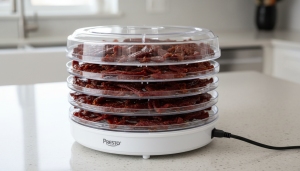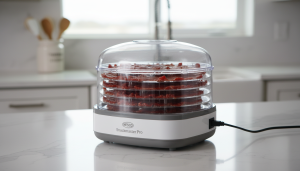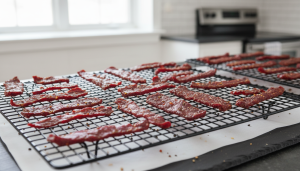Best Dehydrator for Jerky – My Honest Guide & Top Picks
There’s something incredibly satisfying about pulling out a tray of perfectly dried jerky. It’s chewy, flavorful, and keeps for weeks — assuming it lasts that long in my kitchen.
After years of experimenting with different machines, I’ve learned that not all dehydrators handle jerky the same way. Some dry unevenly, some are too noisy, and a few make your whole house smell like a smokehouse (not necessarily a bad thing).
In this guide, I’ll share my best dehydrators for jerky based on hands-on experience, what to look for before buying, and a few pro tips to make your jerky-making smoother.
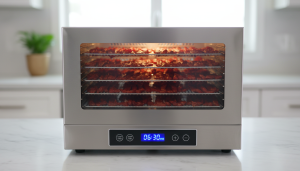
What You’ll Learn in This Guide
-
How to choose a jerky-friendly dehydrator
-
My tested and trusted models
-
Handy tips for better flavor and texture
-
Easy cleaning and maintenance ideas
-
Common mistakes to avoid
Quick Comparison: My Favorite Picks
| Dehydrator | Best For | Highlights |
|---|---|---|
| Excalibur 3926TB | Overall Performance | Precise temperature control, 9 trays, durable build |
| Nesco Snackmaster Pro | Budget Option | Compact, consistent drying, easy to use |
| Cosori Premium Stainless Steel | Modern Design | Quiet motor, even airflow, digital settings |
| Magic Mill Commercial | Large Batches | Metal trays, powerful fan, timer with auto shut-off |
| Presto Dehydro | Beginners | Affordable, stackable, ideal for small batches |
(If you’re still exploring general food drying, you might like my Best Food Dehydrator – Honest Guide with My Top Picks.)
What I Look for in a Jerky Dehydrator
I’ve learned that the best dehydrator for jerky isn’t necessarily the biggest or most expensive. It’s about consistency and control.
Temperature Range and Control
Jerky needs to be dried at around 160°F (70°C) for meat safety and perfect chewiness. Models with adjustable thermostats make this easy. Anything without one? That’s a pass from me.
Airflow and Heat Distribution
Even airflow is a must. Jerky shouldn’t dry faster on one tray than another. Horizontal airflow designs (like Excalibur or Magic Mill) keep things balanced, while vertical ones (like Nesco) work fine for smaller batches.
Capacity
If you make jerky in bulk — say for camping trips or to survive Monday snack cravings — go for at least 6–9 trays. Compact stackable models are fine for casual use.
Ease of Cleaning
Jerky marinade tends to stick. Removable trays and nonstick mesh screens save your sanity. Dishwasher-safe parts? Even better.
Noise Level
Let’s be honest, some dehydrators sound like they’re prepping for takeoff. If you dehydrate overnight, quieter options like Cosori will save your sleep.
My Top Picks for Making Jerky
1. Excalibur 3926TB – Best Overall
If I had to keep only one machine, this would be it.
The Excalibur 3926TB is large, reliable, and practically bulletproof. The rear-mounted fan ensures steady airflow across all trays, so every strip of meat dries evenly — even when I overload it (which happens often).
It also comes with a 26-hour timer and adjustable thermostat, giving me total control. Yes, it takes up some counter space, but it’s worth every inch.
Cleanup is straightforward thanks to the removable trays.
Ideal for: Heavy users, hunters, or anyone serious about jerky-making.
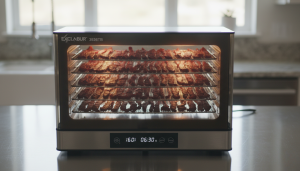
2. Nesco Snackmaster Pro – Best Budget Option
Don’t underestimate this one. The Nesco Snackmaster Pro is compact, affordable, and surprisingly efficient. Its top-mounted fan helps prevent drips from ruining the motor (a clever design choice).
It doesn’t have a timer, which is mildly inconvenient, but I’ve learned to set my phone timer instead. For its price, the performance is fantastic.
Ideal for: Beginners or anyone short on space and budget.
3. Cosori Premium Stainless Steel – Best Looking & Quiet
This one combines style and substance. With stainless steel trays and digital controls, it feels modern yet user-friendly.
The airflow system is whisper-quiet — I can dehydrate overnight without waking the entire house. The automatic shut-off gives peace of mind too.
I also appreciate the transparent glass door, which lets me peek at the jerky without opening it (and losing heat).
Ideal for: Apartment dwellers or night-time dehydrators.
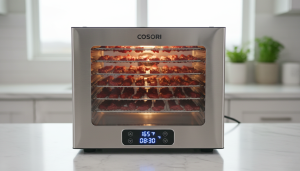
4. Magic Mill Commercial – Best for Large Batches
This dehydrator means business.
The Magic Mill Commercial model is sturdy, with stainless steel trays and a rear fan for even drying. It’s perfect when I’m prepping jerky for a crowd or stocking up before a long trip.
It comes with a digital thermostat and timer, both accurate, plus overheating protection — something I didn’t know I needed until I left one running overnight.
Ideal for: Big families or bulk jerky production.
5. Presto Dehydro – Best for Beginners
If you’re just getting started, Presto’s Dehydro is the friendly face of food dehydration. It’s lightweight, stackable, and easy to store. The drying consistency surprised me for the price.
It doesn’t have temperature precision like the Excalibur, but for simple beef or turkey jerky, it does a fine job. Plus, it’s a good way to test if jerky-making is your thing before investing in pricier gear.
Ideal for: Beginners or light users.
Pro Tips for Making Better Jerky
Over the years, I’ve learned that the dehydrator is only half the equation. The rest comes down to technique — and a little patience.
1. Trim the Fat
Fat goes rancid quickly, so always trim your meat well before slicing. Lean cuts like top round or flank steak are perfect.
2. Marinate for Flavor
A good marinade does wonders. I like to mix soy sauce, brown sugar, garlic, and a pinch of chili flakes. Let it soak for at least 6 hours.
3. Slice Consistently
Uneven slices lead to uneven drying. If you struggle with knife precision, freeze the meat for an hour — it slices cleaner.
4. Don’t Rush the Drying
Jerky isn’t meant to be fast food. Depending on your machine, it can take 4–10 hours. It’s done when it bends but doesn’t snap.
5. Store It Right
Once it cools, seal it in airtight containers or vacuum bags. I store mine in glass jars in a cool spot — it looks nice too.
Cleaning and Maintenance Tips
Cleaning is the least fun part, but it keeps your dehydrator working longer.
Here’s what I do:
-
Wipe trays while still warm — easier to remove residue.
-
Use mild soap and warm water, not harsh chemicals.
-
Avoid soaking electrical parts.
-
Run an empty cycle occasionally to eliminate lingering smells.
If you enjoy kitchen gear care guides, you might like my knife set guide — it pairs nicely with jerky prep. (You can check it out in my blog section.)
Fun Things to Dehydrate Beyond Jerky
Once you start drying meat, you’ll probably want to experiment. I did — and now my dehydrator runs almost weekly. Try these ideas:
-
Apple chips: thin, crisp, and naturally sweet.
-
Herbs: dry basil, mint, and oregano for easy seasoning.
-
Fruit leather: perfect for kids or hikes.
-
Veggie chips: zucchini and beet slices work great.
The same machines that make great jerky handle these effortlessly.
FAQs I Get All the Time
Is a dehydrator better than an oven for jerky?
Yes — dehydrators offer consistent, low heat that dries meat evenly without cooking it. Ovens work in a pinch, but they often run too hot.
How long does homemade jerky last?
Stored properly, it keeps for up to 1–2 months at room temperature, longer in the fridge.
Can I dehydrate chicken or fish?
You can, but handle them carefully and use proper temperatures (165°F minimum). Beef and venison are still the easiest.
My Final Thoughts
Finding the best dehydrator for jerky took me some trial and error — and a few questionable batches. But once I understood how airflow, temperature, and patience come together, the process became second nature.
If you’re just starting, go simple with the Nesco or Presto. If you’re ready to make jerky a weekend tradition, invest in the Excalibur or Magic Mill. Either way, it’s worth it — nothing beats homemade jerky you made yourself.
(Want to explore more versatile options? Check out my full Best Food Dehydrator Guide for broader recommendations.)
